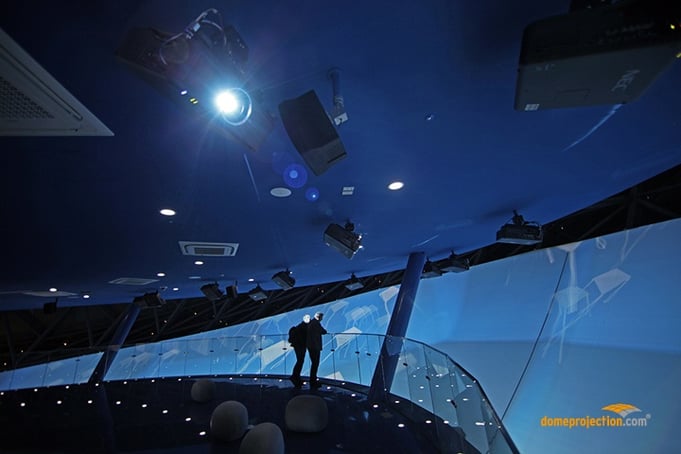 Camera-based automatic projection alignment empowers integrators, show operators and end-users to align and calibrate any number of projection channels in domes, complex projection surfaces, flat or curved surfaces in a cost-efficient way.
Camera-based automatic projection alignment empowers integrators, show operators and end-users to align and calibrate any number of projection channels in domes, complex projection surfaces, flat or curved surfaces in a cost-efficient way.
In this article, we will cover the following topics:
- What is camera-based automatic alignment?
- An example scenario from a live event
- What are the benefits of auto-alignment?
- How many cameras do you need?
What is camera based auto-alignment?
Geometry correction (warping) and blending multiple projectors seamlessly on a complex surface can be a tedious and time-consuming task. Using an automated camera projection alignment system can save time and energy for both initial calibration and recalibration.
The process is simple: Test patterns are projected onto the projection surface, digital camera(s) capture these test patterns and feed them back to the system where they are analyzed. When the analyze is completed, the result is exported to the media server and the projected images are automatically warped and blended to match the surface.
An example scenario from a live event
Imagine that you are the projectionist responsible for setting up the projection in a corporate event in a big ballroom. The client has requested a six-projector setup on a wave-shaped screen. After mounting the projectors in the truss, you mount and align your camera(s) and markers, connect them to the system along with PoE (Power over Ethernet) to feed the camera with power and network, and a network controllable powerplug for the markers.
All to be prepared for running in the automated recalibration process.
The initial setup of the alignment project includes defining/measuring the screen, capturing marker positions, running the pattern generator and performing the first calibration to export warping and blending data.
When finished, you can review the settings and verify that everything is perfect.
When you arrive on site the next morning, you realize that a not-so-friendly janitor has accidentally bumped into the projector – making the perfectly smooth image from yesterday look less than perfect.
This is when you click re-align, and in matter of minutes (since re-alignment is faster that initial setup), you are up and running with a perfectly blended image.
What are the benefits of auto-alignment?
There are a wide number of benefits to be gained from using a fully automated camera calibration system. In addition to the above scenario, fixed installs as well as any live event will benefit from an automated alignment system.
- Fast set-up
With reduced set-up time, the labour costs for installation are reduced – and time can be spent on other things. - Reduced requirements for training
With re-alignment “at your fingertips” you reduce the need for time-consuming and costly training of staff.
- Reduced maintenance cost
With the possibility of re-aligning the entire installation without having a highly trained professional on site, the maintenance costs are reduced dramatically.
- Great looking image all of the time
With the possibility of using an installed camera (or many) and software to automatically re-align the projection installation, you can rest assured that your audience will always see a high quality multi-projection image.
How many cameras do you need?
The camera(s) need to see the whole surface that will be projected. In some installations, you will only require one camera, whilst in others you will require more than one.
 Photo credits:
Photo credits:
Illustration photo (header photo) from domeprojection.com®, and their Four River Pavilion The Arc (Daegu, South Korea) installation. 60m x 20m large seamless projection of 34 channels.
Illustration photo (below), from domeprojection.com®, and their PALM EXPO 2014 in Mumbai, India. The projection was created by BARTKRESA design, a renowned projection mapping specialist domeprojection.com® and Dataton partner Omagica using ProjectionTools.





